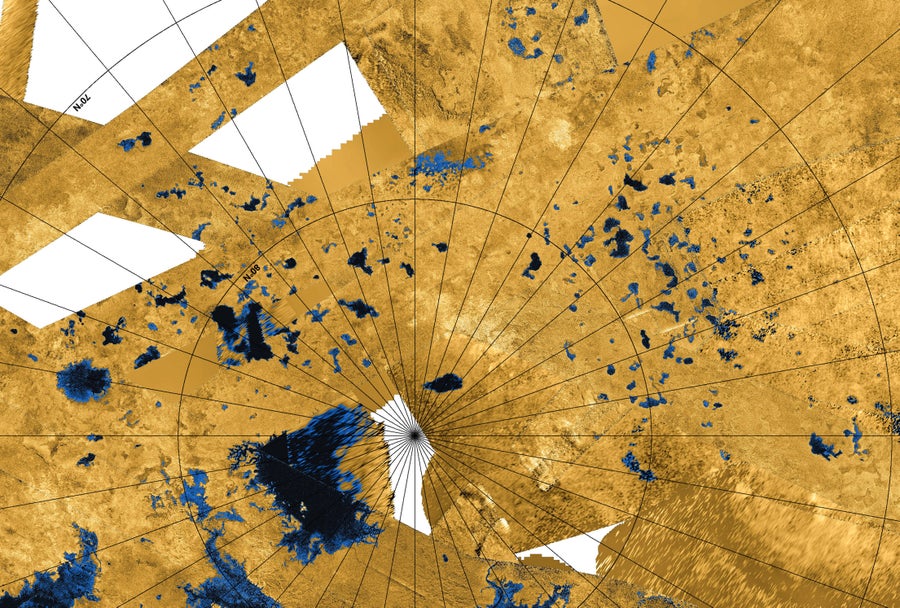This article was published in Scientific American’s former blog network and reflects the views of the author, not necessarily those of Scientific American
Titan's lakes of methane and ethane are some of the most impressive discoveries from the Cassini mission. Although it had long been suspected that Titan could operate a hydrocarbon equivalent of Earth's hydrological cycle (evaporation, condensation, rain-out and accumulation of liquids), it wasn't until Cassini's radar mapping that we knew there were indeed bodies of surface liquid on this distant moon.
There are over 30 named lakes on Titan, ranging from about 240 kilometers across (more of a sea than a lake) to about 6 kilometers. At this time in Titan's seasonal cycle, all of these filled structures are north or south of 70 degrees latitude on the moon's surface.

False color synthetic radar map of Titan's northern polar region, blue indicates surface liquid. Lakes are peppered across the landscape (Credit: NASA / JPL-Caltech / Agenzia Spaziale Italiana / USGS).
On supporting science journalism
If you're enjoying this article, consider supporting our award-winning journalism by subscribing. By purchasing a subscription you are helping to ensure the future of impactful stories about the discoveries and ideas shaping our world today.
But what forms these depressions in the landscape, along with similar - but currently empty - features at lower latitudes?
A new study by Cornet et al. in the Journal of Geophysical Research, suggests a remarkably terrestrial-like, yet alien, process may be at play.
The Earth's surface is littered with places where the landscape is a result of the dissolution of soluble rocks by eons of water erosion (most of west-central Florida for example). Limestone, together with other rocks, is dissolved by the carbonic acid in natural rainwater. With enough time, whole mountains can give way to sinkholes and caves as the rock is eaten away - a so-called karst topography. And with enough precipitation, land-locked lakes can form in these depressions.
For terrestrial karstic landforms there are some fairly straightforward ways to estimate the time it takes for landscape features to form - essentially by computing the rate at which rock is dissolved and comparing that to the volume of material that has to have been washed away.
For Titan the researchers applied the same approach, but tailored to the likely mix of carbon-rich material forming a surface layer (perhaps a few hundred meters deep) and the dissolving power of liquid methane, ethane, and propane as they rain out of the atmosphere. By tying these factors together with the predicted summer rainfall on Titan - from computer simulations of the Titanian climate - they show that in polar regions a karst topography of lakes could form in a few tens of millions of years, while at the drier latitudes it could take hundreds of millions of years.
These timescales are also neatly consistent with the estimated ages of these surfaces.
The rate at which the lakes form are some 30 times slower than on Earth, which is not surprising given the different ingredients, a brisk 90 Kelvin typical temperature, and seasons that come and go almost precisely 30 times slower (Saturn's orbit is 29.5 Earth years).
Once again, Titan - for all of its utterly un-earthly characteristics - is seemingly sculpted by a set of universal planetary processes. It's an excellent example of how our quest to discover and explore new worlds is ultimately deeply connected to understanding the Earth itself.